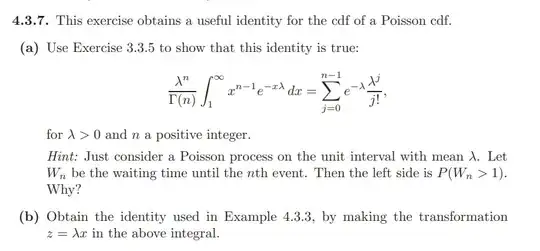My question is how does the left hand side equation for part a equal to the probability $P(W_n >1)$ where $W_n$ is a Poisson process on the unit interval with mean $\lambda$? The method I used to prove part a is using the gamma and beta functions.
Asked
Active
Viewed 438 times
1
-
https://math.stackexchange.com/q/1960133/321264, https://math.stackexchange.com/q/467341/321264, https://math.stackexchange.com/q/2205444/321264 – StubbornAtom Sep 28 '20 at 03:51
1 Answers
1
- The waiting time until the $n$th event can be written as $W_n = T_1 + T_2 + \cdots + T_n$, where $T_i$ is the waiting time between the $(i-1)$th event and the $i$th event (and where $T_1$ is the waiting time until the first event).
- For a Poisson process with rate $\lambda$, the $T_i$ are i.i.d. exponential random variables with rate $\lambda$.
- The sum of $n$ independent $\text{Exponential}(\lambda)$ random variables can be shown to follow a $\text{Gamma}(n, \lambda)$ distribution, whose density appears in the left-hand side of the equation you are asking about.
angryavian
- 89,882
-
Does this mean that if we add an infinite amount of exponential random variables that are all iid, will we eventually get a poisson distribution? – Some_Math_Nerd Sep 28 '20 at 03:11
-
@Some_Math_Nerd I think you are misinterpreting what the equation says. It doesn't say "gamma distribution is approximately a Poisson distribution," rather it says "if $W_n \sim \text{Gamma}(n, \lambda)$ and $N \sim \text{Poisson}(\lambda)$, then $P(W_n > 1) = P(N < n)$. – angryavian Sep 28 '20 at 03:23
-
Yes, but the problem states that this is a poisson process and according to the textbook from an earlier chapter it gives the definition of a poisson process as "A process which leads to a Poisson distribution is called a Poisson process." I guess my question is that how does this lead to a poisson distribution? – Some_Math_Nerd Sep 28 '20 at 03:27
-
@Some_Math_Nerd Yes, my answer is in the context of a Poisson process with rate $\lambda$. The definition of Poisson process that you gave is missing a lot of context. The relationship between a Poisson process with rate $\lambda$ and the Poisson distribution is that the number of arrivals in an time interval of length $t$ is $\text{Poisson}(\lambda t)$. – angryavian Sep 28 '20 at 03:39
-
Ok that makes sense, but is there a way to get $P(W_n > 1) = P(N < n)$ without using calculus since the problem states that this is a hint, or do you know of any reference I can get information on this equation? – Some_Math_Nerd Sep 28 '20 at 03:45
-
